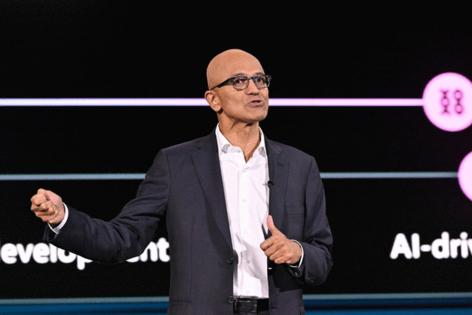Microsoft rode the cloud to new heights. Can it do the same with AI?
Published in Business News
When Satya Nadella entered Microsoft’s C-suite in 2014, the company wasn’t one of the tech darlings dazzling Wall Street.
After founder Bill Gates turned the CEO role over to Steve Ballmer in 2000 and until Ballmer stepped away in 2014, Microsoft’s stock price basically followed the market. The company was still printing money thanks to its dominance in personal computing software. But it couldn’t draw futurist headlines like those chasing companies that represented FAANG, a catchall acronym for Facebook, Apple, Amazon, Netflix and Google, the sexy tech stocks of the early 2010s.
While Apple and Google seized the smartphone market, Microsoft fumbled its Windows-powered cellphone. As it revolutionized retail, Amazon also beat Microsoft to the punch on cloud computing with its debut of Amazon Web Services in 2002.
Microsoft was resting on its laurels, even if those behind the scenes were feverishly trying to break into new markets with ultimately doomed products like the Zune.
Enter Nadella, the engineer. Climbing through the ranks at Microsoft in various product divisions, Nadella had found a way at each stop to bring the company into a new digital age: take it to the cloud.
As a concept, cloud computing is abstract. It took years to drag customers, both commercial and consumer, into Microsoft’s cloud umbrella, Azure. But the bet paid off.
And with the winnings, Nadella and others are pushing more chips each year into a technology better known than cloud computing but perhaps even less understood: artificial intelligence.
From July 2024 through June 2025, the company projects it will have spent $80 billion on AI infrastructure, mostly by building data centers. That represents almost 33% of Microsoft’s total revenue for 2024, which the company reported as $245 billion.
Microsoft isn’t all in, but it’s still a big bet for a company worth $2.9 trillion.
To the cloud
You’d be hard-pressed to find someone who says “send that to me in a WordPerfect document.” Nobody tracks their company budget in a Lotus 1-2-3 spreadsheet. Two applications that were ubiquitous for computer users in the 1980s are now completely lost to history thanks to Microsoft Office.
Those Office products — chiefly Word, PowerPoint and Excel — once drove the Redmond-based tech giant. Under Nadella, cloud computing outstripped them all.
When Nadella was named CEO, Office and the cloud were essentially tied in terms of revenue. Office brought in $24.3 billion in revenue. Microsoft’s cloud computing division reported $21.7 billion in sales that year.
Cloud computing is booming for Microsoft. Last year, Intelligent Cloud reported more than $100 billion in annual sales. Office’s revenue was about half of that.
Though tens of thousands of employees are underneath Nadella developing Microsoft’s successful cloud products, it’s Microsoft’s chief who’s been credited with turning around a company that continually failed to stay on the cutting edge of technology for more than a decade.
Windows didn’t make a dent in the smartphone market, now the domain of Apple’s iOS and Google’s Android operating systems. The ill-fated Zune didn’t take down the iPod. And though MSN looked to be a contender as a search platform early on, the company lost interest in capturing that market before Google did.
Though it’s a success now, Microsoft was late in launching its cloud platform, Azure. Amazon Web Services had entered the arena in 2002, six years before Azure did.
Amazon spent that time gobbling up market share. While Microsoft and others were growing cloud services slowly, Amazon Web Services was humming. Amazon still has a healthy lead in the cloud market, with about 30% of it, according to the Synergy Research Group. But Microsoft’s share has climbed to 21%.
After more than a decade of dragging customers to the cloud, Nadella and Microsoft are pulling them toward AI, a technology that’s costly, unreliable and greedy, using vast amounts of energy and water, but potentially extraordinarily lucrative.
General-purpose technology
Tech companies have developed large language models and machine learning products for the past decade that fall under AI. It’s technology that allows a robot vacuum to clean a house more efficiently and produces better predictive ads while you’re browsing the internet.
But the flashier products are in the zeitgeist now. Chatbots that can craft essays and image generators that produce uncanny pictures are all available to the public.
The tech industry is scrambling to include AI — or at least the term AI — in new products, annual earnings calls and marketing efforts. Facebook parent company Meta injected AI chatbots into its social media platforms, while Expedia has an AI feature for travel planning and Google’s search has been handed over to the technology. For about $1,000, you can even own the world’s first AI-enabled grill from a company called Brisk It.
Microsoft’s biggest consumer-facing AI product has been Copilot, a complement to the company’s Office products that can automate tasks.
Behind the scenes, Microsoft plans to pour money into AI. In a regulatory filing from October, Microsoft said it has committed $13 billion in investments toward OpenAI, an AI research organization that develops chatbots and image generators. Microsoft has such a large investment in the ChatGPT maker that it reported a $683 million expense due to its equity stake.
As Wall Street rides the roller coaster of AI hype, Microsoft claims it’s chasing the technology almost altruistically. The company believes that AI is a general-purpose technology.
“A single-purpose technology is a great advancement and helps a lot of people,” said Mary Snapp, vice president of strategic initiatives for Microsoft, in an interview with The Seattle Times. “Like my electric sewing machine when I was growing up. Boy, I sewed a lot of clothes and it got me to the prom, but it didn’t do anything else.”
But an example of general-purpose technology, she said, is electricity. It spawns innovation and boosts productivity.
An ambassador for the company’s policy and tech efforts, Snapp travels around the world trying to demystify AI and advocate for retraining workforces. She likens it to the government trying to drive social acceptance of electricity in rural areas in the 1930s to build the electric grid.
“We needed people to know how to run electrical appliances at scale and in industrial settings,” Snapp said. “We’re going to need the same thing with artificial intelligence.”
AI in action
In early March, Microsoft President Brad Smith was in Tanzania to see Microsoft’s AI for Good Research Lab in the field. The technology’s selling point is improved productivity and efficiency in any setting. So, how could it help conservation?
The lab had been partnering with the Wild Nature Institute, a conservation group, and was working with the organization to track the East African country’s giraffe population.
“Turns out that AI is critical,” Smith said in an interview with The Seattle Times. “Every giraffe is unique, so for decades, these scientists would go out into the wild and they would have these diagrams of the giraffes that were drawn. Now you take a photograph, AI crops it, and then it instantaneously matches that giraffe to the giraffe in the data set.”
Outside of Microsoft’s research efforts, the company has already introduced its customers to AI. Deb Cupp, president of Microsoft’s business operations across North America and South America, is in charge of an $80 billion products business that’s now tasked with delivering AI to customers and educating them on the technology.
“We spent time explaining what AI was and where the areas of opportunity actually were,” she says. “We started to help customers think through whether they should try and create use cases, finding ways to fit in the technology. But the answer is actually the complete opposite.”
Renton-based Providence Health & Services said it’s been working with the tech giant to identify use cases for AI. Health care has been moving to the digital world for the past 10 to 15 years, a move that Providence said has set it up for AI.
Susan Huang, chief physician executive for health care giant Providence, said AI already has more buy-in than the organization’s move to the cloud years ago.
“AI is part of the colloquial dialogue whereas cloud-based services were somewhat niche,” Huang said. “Whether you’re a caregiver, doctor or nurse, everyone has an idea for how AI can be applied. And they’re already using it on the outside and in their personal lives.”
Hype or real?
Two major issues hang over AI.
It uses a lot of energy. The International Energy Agency said in a report last year that from 2022 to 2026, global electricity demand from data centers could double in part due to AI. The demand from data centers would be roughly equal to the entire electricity consumption of Japan.
The average amount of electricity used in a traditional Google search is 0.3 watt-hours. For a ChatGPT request, it’s about 2.9 watt-hours, the equivalent of running an LED light bulb for roughly 17 minutes.
Essentially the company is looking in the margins for where it can cut back on energy and water consumption while tightening AI’s belt. If the models and code can be more efficient, they’ll use less energy with each request.
AI’s other issue is its tendency to hallucinate.
Google’s Gemini feature regularly spits back incorrect information, as it’s drawing from unreliable sources across the internet. OpenAI’s ChatGPT has made up facts and gets tricked by word problems. Grok, the AI platform for X, routinely aggregates trendy jokes and reports them back as news.
A recent study from the Columbia Journalism Review found that AI search tools were “generally bad at declining to answer questions they couldn’t answer accurately, offering incorrect or speculative answers instead.”
Former Microsoft Chief Technology Officer Nathan Myrhvold believes it will take a miracle or maybe five for AI to reach human-level understanding.
At Geekwire’s Microsoft@50 anniversary event March 20, Myrhvold expressed optimism for AI. But the feature it lacks is the ability to take abstract concepts and find meaning, as humans can. It can’t reason in the abstract as humans do until a miracle happens.
“And that could happen tomorrow. Or maybe it already happened tonight and they just haven’t told us,” Myrhvold said. “Or it could take another 10 years.”
For now it’s about getting a return on investment and satisfying Wall Street. How Microsoft makes money through AI is a bit murky because it’s injecting the technology throughout its revenue segments.
But Nadella gave analysts a good sales pitch in January, during the company’s latest earnings call. The company said its AI business has a revenue run rate, effectively a projection of revenue for the next year, of $13 billion. On the same day, Microsoft revealed it spent $22.6 billion in a single quarter on AI infrastructure. Nadella and the company deem those rising expenditures necessary.
“As AI becomes more efficient and accessible,” Nadella said, “we will see exponentially more demand.”
_____
©2025 The Seattle Times. Visit seattletimes.com. Distributed by Tribune Content Agency, LLC.












Comments